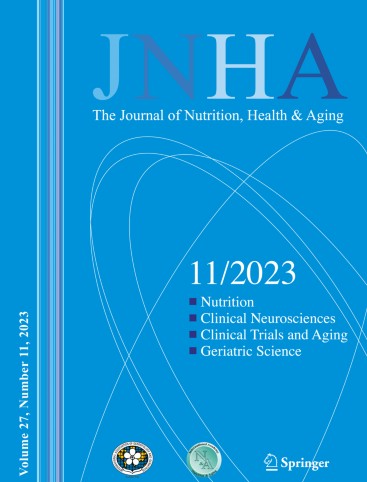胰岛素抵抗代用指标预测老年人功能衰退的能力因性别而异
IF 4.3
3区 医学
Q1 GERIATRICS & GERONTOLOGY
引用次数: 0
摘要
目的通过胰岛素抵抗稳态模型(HOMA-IR)确定的胰岛素抵抗与非糖尿病老年人的功能衰退有关。然而,胰岛素并不是常规评估指标。该研究评估了非胰岛素依赖型红外替代物对非糖尿病老年男性和女性功能衰退的预测价值。研究对象包括托莱多健康老龄化研究(Toledo Study of Healthy Aging)中的 615 名老年参与者。方法在基线和随访 5 年后,用虚弱特质量表-5(FTS-5)评估虚弱程度。193名受试者出现功能衰退(FTS-5得分下降2.5分)。考虑到潜在的混杂因素,多变量回归模型分析了五种已描述的 IR 代用指标对功能衰退的影响。结果在所有参与者中,甘油三酯血糖-体重指数(TyG-BMI)和 HOMA-IR 与功能衰退风险增加显著相关(奇异比(95% 置信区间)TyG-BMI:1.16 (1.05, 1.28),p = 0.0035;HOMA-IR:1.59 (1.15, 2.21),p = 0.0056)。结论只有 TyG-BMI 指数模拟了基于胰岛素的 IR 指标的预测能力。IR指标的预测能力具有性别特异性,TyG-BMI是唯一能够预测女性功能衰退的指标,而HOMA-IR则是唯一能够预测男性功能衰退的指标。本文章由计算机程序翻译,如有差异,请以英文原文为准。
Gender-specific capacity of insulin resistance proxies to predict functional decline in older adults
Objectives
Insulin resistance determined by Homeostasis Model of Insulin Resistance (HOMA-IR) has been associated with functional decline in non-diabetic older subjects. However, insulin is not routinely assessed. The study evaluated the predictive value of non-insulin-dependent IR surrogates on functional decline in non-diabetic older men and women.
Design and participants
Prospective cohort study over 5 years. The study included 615 older participants from the Toledo Study of Healthy Aging.
Methods
Frailty was assessed by the Frailty Trait Scale-5 (FTS-5) at baseline and after 5 years follow-up. 193 subjects experienced functional decline (2.5-point reduction in the FTS-5 score). Multivariate regression models analysed the effect of five described IR surrogates on functional decline considering potential confounders.
Results
Among evaluated IR proxies, triglyceride glucose-body mass index (TyG-BMI) and HOMA-IR were significantly associated with an increased risk of functional decline (odd ratio (95% confidence interval) TyG-BMI: 1.16 (1.05, 1.28), p = 0.0035 and HOMA-IR: 1.59 (1.15, 2.21), p = 0.0056) among all participants. When stratified by gender, HOMA-IR was related to functional decline in men [2.02 (1.13, 3.59), p = 0.0173] and TyG-BMI in women [1.19 (1.05, 1.35), p = 0.0057].
Conclusions
Only TyG-BMI index mimics the predictive capacity of insulin-based IR marker. The predictive ability of IR indexes is gender-specific, being TyG-BMI the only index able to predict functional decline in women and HOMA-IR in men.
求助全文
通过发布文献求助,成功后即可免费获取论文全文。
去求助
来源期刊
CiteScore
7.80
自引率
3.40%
发文量
136
审稿时长
4-8 weeks
期刊介绍:
There is increasing scientific and clinical interest in the interactions of nutrition and health as part of the aging process. This interest is due to the important role that nutrition plays throughout the life span. This role affects the growth and development of the body during childhood, affects the risk of acute and chronic diseases, the maintenance of physiological processes and the biological process of aging. A major aim of "The Journal of Nutrition, Health & Aging" is to contribute to the improvement of knowledge regarding the relationships between nutrition and the aging process from birth to old age.

 求助内容:
求助内容: 应助结果提醒方式:
应助结果提醒方式:


